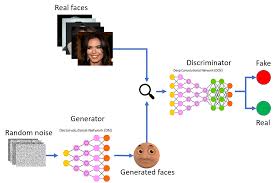Generative Neural Networks: Unlocking the Power of Artificial Intelligence
In the realm of artificial intelligence, generative neural networks have emerged as a groundbreaking technology with the potential to revolutionize various industries. These advanced systems are designed to generate new data that is indistinguishable from real data, opening up a world of possibilities for applications in fields such as image generation, text-to-speech synthesis, and even drug discovery.
At the core of generative neural networks is their ability to learn patterns and structures from existing data and then use that knowledge to create new, original content. This process is made possible through complex algorithms and layers of interconnected nodes that mimic the way neurons in the human brain function.
One of the most popular types of generative neural networks is the Generative Adversarial Network (GAN), which consists of two neural networks – a generator and a discriminator – that work in tandem to produce realistic outputs. The generator generates new data samples, while the discriminator evaluates these samples to determine if they are real or fake. Through this adversarial training process, GANs can produce high-quality outputs that closely resemble real data.
The applications of generative neural networks are vast and diverse. In the field of computer vision, GANs have been used to generate photorealistic images from textual descriptions, enhance low-resolution images, and even create deepfakes. In natural language processing, these networks have been employed to generate human-like text, translate languages, and summarize documents with remarkable accuracy.
Moreover, generative neural networks have shown great promise in healthcare by facilitating drug discovery through virtual screening and molecular design. By generating novel chemical compounds with desired properties, these networks can significantly accelerate the drug development process and potentially lead to breakthrough treatments for various diseases.
As research in generative neural networks continues to advance, we can expect even more exciting developments in AI-driven creativity and innovation. From art generation to music composition to content creation, these powerful systems are reshaping the way we interact with technology and pushing the boundaries of what is possible in the realm of artificial intelligence.
5 Essential Tips for Success with Generative Neural Networks
- Start with a simple architecture before moving to more complex ones.
- Ensure your training data is diverse and representative of the desired outputs.
- Regularize your model to prevent overfitting, especially with limited data.
- Experiment with different hyperparameters to optimize performance.
- Consider using pre-trained models or transfer learning to speed up training and improve results.
Start with a simple architecture before moving to more complex ones.
When delving into the realm of generative neural networks, it is advisable to begin with a simple architecture before venturing into more complex ones. By starting with a straightforward model, you can gain a solid understanding of the fundamental principles and mechanisms behind generative networks. This approach allows you to grasp the basics of how data is generated and how different layers interact within the network. Once you have a strong foundation, you can gradually explore more sophisticated architectures and techniques, building upon your knowledge and experience to create more advanced and effective generative models.
Ensure your training data is diverse and representative of the desired outputs.
To maximize the effectiveness of your generative neural network, it is crucial to ensure that your training data is diverse and representative of the desired outputs. By incorporating a wide range of examples that accurately reflect the variations and nuances present in the real-world data, you can improve the network’s ability to generate high-quality and realistic outputs across different scenarios. A diverse training dataset helps the neural network learn patterns and relationships more effectively, leading to more accurate and reliable results in generating new content.
Regularize your model to prevent overfitting, especially with limited data.
To optimize the performance of your generative neural network, it is crucial to incorporate regularization techniques to prevent overfitting, especially when working with limited data. Overfitting occurs when a model learns the training data too well, capturing noise and irrelevant patterns that hinder its ability to generalize to unseen data. By applying regularization methods such as dropout, weight decay, or early stopping, you can effectively control the complexity of your model and improve its ability to generalize, even in scenarios where data is scarce. This proactive approach ensures that your generative neural network maintains robustness and accuracy while avoiding the pitfalls of overfitting that can compromise its predictive power.
Experiment with different hyperparameters to optimize performance.
When working with generative neural networks, it is crucial to experiment with different hyperparameters to optimize performance. Hyperparameters such as learning rate, batch size, and network architecture play a significant role in the training process and can greatly impact the quality of the generated outputs. By systematically adjusting these parameters and observing their effects on the network’s performance, researchers and developers can fine-tune their models to achieve better results and enhance the overall efficiency of the generative neural network.
Consider using pre-trained models or transfer learning to speed up training and improve results.
When working with generative neural networks, it is highly beneficial to consider utilizing pre-trained models or transfer learning techniques. By leveraging existing models that have been trained on large datasets, you can significantly speed up the training process and enhance the quality of your results. Pre-trained models provide a solid foundation of knowledge that can be fine-tuned to suit your specific task or dataset, saving time and computational resources while improving the overall performance of your generative neural network.



